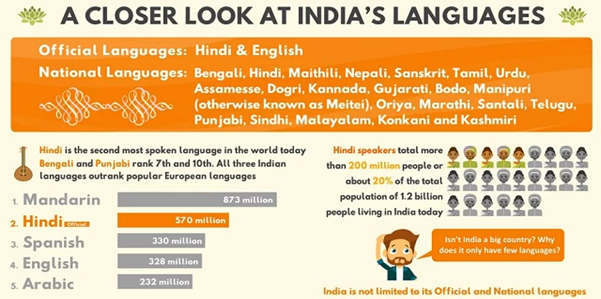

Context
In sync with one of the focal points of the National Education Policy (NEP) 2020, the promotion of Indian languages in higher education, the Union minister has suggested introducing Indian languages in the study of Engineering, law, and medicine in the country.
Background
- The NEP provides for higher education institutions and programs in higher education to use the mother tongue or local language as a medium of instruction, besides offering programs bilingually.
- About 95% of students, who receive primary education in their mother tongue, face difficulty during their Higher education and should not be left out in their pursuit of higher studies.
- The AICTE approved 19 engineering colleges in 10 States for having engineering courses in six Indian languages effective from 2021-22 sessions.

Analysis
Is there an actual need to introduce the regional languages in higher studies?
- Language is closely related to culture and therefore to the customs of people. Besides, the massive spread of education and growth of mass literacy can only occur through the medium of the mother tongue.
- Democracy can become real to the common people only when politics and administration are conducted through a language they can understand.
- Hence language plays an important role in the social and economic development of the region.
|
The language policy of India is basically embodied in Part XVII of the Indian Constitution along with the 8th schedule in reference to articles 344 and 351 (which specify the languages of India for purposes mentioned in these 2 articles), and the articles concerning Fundamental Rights regarding language, education, and culture, etc. |
- While education has always bridged the gap between the haves and have-nots, the lack of programmes in regional languages, especially in higher education, has made it difficult for many to continue with their education. Hence, Including Regional languages can be a move forward in filling gaps.
Positive Aspects of Higher Education in Regional Language
- Subject-Specific Improvement:Several studies in India and other Asian countries suggest a positive impact on learning outcomes for students using a regional medium rather than the English medium.
- Performance in science and math,in particular, has been found to be better among students studying in their native language compared to English.
- Higher Rates of Participation:Studying in the native language results in higher attendance, motivation, increased confidence for speaking up among students, and improved parental involvement and support in studies due to familiarity with the mother tongue.
- Poor grasp of English has been tied by many educationists to dropout rates at the premier engineering education institutions as well as poor performance of some students.
- Additional Benefits for the Less-Advantaged:This is especially relevant for students who are first-generation learners (the first one in their entire generation to go to school and receive an education) or the ones coming from rural areas, who may feel intimidated by unfamiliar concepts in an alien language.
- Increase in Gross-Enrolment Ratio (GER):This will help provide quality teaching to more students and thus increase Gross Enrolment Ratio (GER) in higher education.
- Promotes Linguistic Diversity:It will also promote the strength, usage, and vibrancy of all Indian languages.
- This way, private institutions too will be motivated to use Indian languages as a medium of instruction and/or offer bilingual programmes.
- It would also help prevent language-based discrimination.
Associated Challenges:
- Insignificant for Institutions with Pan-India Admissions: A regional language focus is not meaningful in a scenario where the institutes see entrants from across the country such as IITs.
- Availability of Quality Material in Regional Languages: Another challenge is the availability of study material such as textbooks and scholarly literature.
- Also, quality control of these translations will be of utmost importance to keep semantic irregularities at bay.
- Availability of Faculty: Given the English-medium legacy of higher education in India, attracting and retaining quality teachers who are willing and able to teach in regional languages will be a challenge.
- Maintaining Pace with Global Standards: Delivering technical courses in regional languages may prevent students from competing in global labour and education markets, where fluency in English yields a distinct edge.
- A lack of opportunities for Indian students at the international level may prove counterproductive to the NEP, 2020’s aim of bridging the gap between elites and the rest.
- It also goes against the vision of promoting the internationalization of education.
Way forward
- To develop a hybrid approach: While it may not be possible to translate technical terms verbatim in the regional languages, a hybrid approach can be developed.
- This will enable a local-global integration with the latest knowledge and technology and give students global exposure and expertise.
- Pre-planning: In the NEP 2020, the government has urged universities to create study material in regional languages to enhance students’ understanding and empower them.
- Expand physical infrastructure of Institutions: If higher education programmes are offered in regional languages, there is no doubt that student enrolment will increase exponentially. Hence Infrastructure needs to be enhanced for more admissions.
- Promote Digital Education: To make programmes in regional languages functional and useful, institutions will have to substantially improve and improvise.
- Field-specific targets: For example; in the field of law — before the subject is taught in the Indian languages — the Central government should try to impress upon the judiciary to allow the use of Indian languages in court proceedings.
|
Recent Developments
|
Conclusion
A holistic approach is required for the implication of native-language instruction in an increasingly globalized world. A shift from “mother tongue versus English" towards the “mother tongue plus English" is required.

